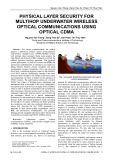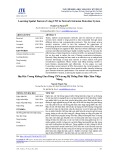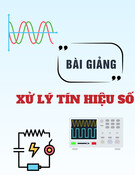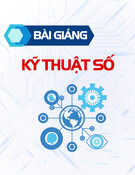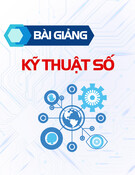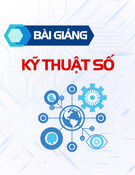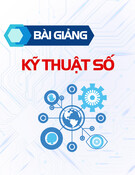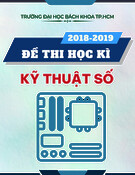
PART zyxwvutsrqponmlkjihgfedcbaZYXWVUTSRQPONMLKJIHGFEDCBA
4
MULTIMEDIA
NETWORKS
Networks and Telecommunications: Design and Operation, Second Edition.
Martin P. Clark
Copyright © 1991, 1997 John Wiley & Sons Ltd
ISBNs: 0-471-97346-7 (Hardback); 0-470-84158-3 (Electronic)

Broadband, Multimedia Networks
and the
B-ZSDN zyxwvutsrqponmlkjihgfedcbaZYXWVUTSRQPONMLKJIHGFEDCBA
The emergence
of
‘multimedia’ computers and software which use all sorts
of
different audio,
data, image and video signals simultaneously has heralded
a
new generation
of
computers and
computer ‘applications’ and spurred the need to develop and deploy a new universal technology
for telecommunications. The broadband-ISDN
(B-ISDN)
will be this new universal technology.
It will be
a
powerful network, capable of carrying many different types of services and
communication bitrates. zyxwvutsrqponmlkjihgfedcbaZYXWVUTSRQPONMLKJIHGFEDCBA
25.1
MULTIMEDIA APPLICATIONS: THE DRIVER
FOR BROADBAND NETWORKS
A zyxwvutsrqponmlkjihgfedcbaZYXWVUTSRQPONMLKJIHGFEDCBA
multimedia
application is one in which different types of communication signal are
transmitted simultaneously. Thus, for example,
multimedia
computers are able simul-
taneously to present spreadsheets, work processing and presentation foil ‘windows’
on
the screen while simultaneously also showing a video, projecting a ‘video telephone call’
and playing a soundtrack (Figure
25.1).
Multimedia applications greatly increase the
possibilities
of
the modern computing and entertainment industries, and they are
finding their way into
all
walks
of
modern life: zyxwvutsrqponmlkjihgfedcbaZYXWVUTSRQPONMLKJIHGFEDCBA
e
Teleworking zyxwvutsrqponmlkjihgfedcbaZYXWVUTSRQPONMLKJIHGFEDCBA
0
Telemedicine
e
Tele-education
0
Teleshopping zyxwvutsrqponmlkjihgfedcbaZYXWVUTSRQPONMLKJIHGFEDCBA
439
Networks and Telecommunications: Design and Operation, Second Edition.
Martin P. Clark
Copyright © 1991, 1997 John Wiley & Sons Ltd
ISBNs: 0-471-97346-7 (Hardback); 0-470-84158-3 (Electronic)

440 zyxwvutsrqponmlkjihgfedcbaZYXWVUTSRQPONMLKJIHGFEDCBA
BROADBAND, MULTIMEDIA NETWORKS AND THE B-ISDN zyxwvutsrqponmlkjihgfedcbaZYXWVUTSRQPONMLKJIHGFEDCBA
Figure
25.1
A
modern multimedia computer workstation zyxwvutsrqponmlkjihgfedcbaZYXWVUTSRQPONMLKJIHGFEDCBA
(Courtesy
of
Siemens zyxwvutsrqponmlkjihgfedcbaZYXWVUTSRQPONMLKJIHGFEDCBA
AG)
The simplest type of
teleworking
is that allowing a company executive to log his laptop
PC
into the company computer network and electronic mail facility no matter what his
location. Thus working at home and during time away on a business trip becomes
possible. Other forms of
teleworking
include applications designed to bring together
groups of remotely located individuals inio a
workgroup (workgroup applications).
A
telemedicine
application might allow a group of specialist surgeons (in different
locations) to carry out an emergency operation together, whde sharing sight of a video
signal broadcast from the operating theatre, as well as full reference to a patient’s
medical records and historic X-rays.
A
distant surgeon could indicate directly on the
video exactly where an incision should be made,
or
maybe even conduct some of the
surgery himself.
Tele-education
offers the prospect of sharing the best possible educational facilities,
information resources and equipment between a large number of dispersed locations.
Thus books, video lectures and demonstrations can be available to students, even in
their own homes.
Multimedia applications are also flourishing in the home environment. Here, cable
television companies already widely offer ‘cable’ connections bringing simultaneous live
television, public telephone service and
video-on-demand
services, as well as
teleshop-
ping
(catalogue shopping from the television or computer screen).

VIDEO zyxwvutsrqponmlkjihgfedcbaZYXWVUTSRQPONMLKJIHGFEDCBA
COMMUNICATION zyxwvutsrqponmlkjihgfedcbaZYXWVUTSRQPONMLKJIHGFEDCBA
441
25.2 VIDEO COMMUNICATION
The advance in video coding schemes and videocommunications has been one of the
main contributing factors in the rapid emergence of multimedia applications.
A
number
of standards have laid the basis for standardized coding of video information, provid-
ing for different qualities and bitrates. At the low bitrate end of the scale, ITU-T recom-
mendation H.261 provides a standard algorithm for a videoconference zyxwvutsrqponmlkjihgfedcbaZYXWVUTSRQPONMLKJIHGFEDCBA
codec (coder/
decoder),
suitable for coding relatively static images for transmission across low bitrate
digital lines. Transmission at rates even as low as 64 kbit/s are possible, giving accept-
able quality for a ‘picture telephone’ conversation or a
videoconference
between seated
(and therefore relatively slow moving) participants in two or more different meeting
room locations locations.
The H.261 algorithm works in a similar manner to ADPCM (Chapter 38). In effect
the whole area of a video screen is assumed to be made up of a matrix of dots, each of a
given colour (typically one of 256 shades). Thus each dot
(orpixel, picture element)
may
be represented by an 8-bit digital value. The entire picture can be represented by
sending all the digital values corresponding to the complete picture dot matrix (or bit
map like the fax image discussed in Chapter 4). As a large number of dots make up the
picture, it takes a little while at the start to establish the initial video
frame.
However,
once the first frame has been established, it is sufficient to send the information
corresponding to the difference between ‘freeze frames’ to recreate all subsequent
frames. Provided that the movement of the image is relatively restricted, sending only
the differences in the picture enables a much lower transmission bitrate to be used.
At 384 kbit/s, fairly high quality video images can be reproduced using the H.261
algorithm, and even public television signals are easily recognizable. The quality, how-
ever, does not match that of the original signal. For this reason, a number of other
coding techniques are also used, where very high quality video images are to be stored
and transmitted in conjunction with modern computer storage devices and telecom-
munications networks. These are the standards of the
Motion Pictures Experts Group
(MPEG),
an industry common-interest group of major companies, cooperating to
promote standards in this area.
25.3 THE EMERGENCE
OF
THE B-ISDN
The demands of new graphical computer software, the emergence of videotelephony
and cable television, and the political pressure for the development of the
Information
Highway
have all combined in their various ways to stimulate the development of
switched
broadband
networks. The result has been the development of
broadband ISDN
(broadband integrated services digital network,
or
B-ISDN).
We saw in Chapter 10 how the
integrated services digital network (ISDN)
was one
step in the development chain of a universal
integrated network,
and how it may replace
the conventional telephone and data networks in the next few years. However,
narrow-
band ISDN (N-ISDN)
in its current form falls a long way short of the ultimate needs of a
multi-service network, because of the relatively restricted bit rate available
on
individual
channels and because of the lack
of
service flexibility arising from the fact that it evolved

442 zyxwvutsrqponmlkjihgfedcbaZYXWVUTSRQPONMLKJIHGFEDCBA
BROADBAND, MULTIMEDIA NETWORKS AND THE B-ISDN
Television zyxwvutsrqponmlkjihgfedcbaZYXWVUTSRQPONMLKJIHGFEDCBA
@ zyxwvutsrqponmlkjihgfedcbaZYXWVUTSRQPONMLKJIHGFEDCBA
e
%
?k!i\al
audio
Multiservice zyxwvutsrqponmlkjihgfedcbaZYXWVUTSRQPONMLKJIHGFEDCBA
Figure
25.2
The concept
of
the
Broadband Integrated Services Digital Network (B-ISDN)
out
of
telephone network principles. The maximum rate currently possible on ISDN is zyxwvutsrqponmlkjihgfedcbaZYXWVUTSRQPONMLKJIHGFEDCBA
n
X
64
kbit/s, up to
2
Mbit/s. Such rates are not enough for very high speed file transfer
between mainframe computers, or for interactive switching of broad bandwidth signals
such as high definition television (HDTV) and video.
Increasing the unit bit rate
(64
kbit/s) of ISDN would increase bit rates and make
broadband
and
multimedia
services possible, but it would be at the expense of gross
inefficiency in network resources, particularly when carrying bursty data signals.
So
B-ISDN is not merely an extension of N-ISDN, but instead also capitalizes on the latest
data switching techniques.
Current world technical standards for B-ISDN describe the general functions which
are
to
be performed by a B-ISDN, and define the network interfaces to be used, but the
technological details are not yet fully defined.
25.4
THE SERVICES TO
BE
OFFERED
BY
B-ISDN
The services offered by B-ISDN networks split into two categories:
interactive services
and
distribution services
(Figure
25.3
shows).
Interactive services
are normal communications between just two parties. There are
three subtypes: messaging, conversational and retrieval services.
An
example of a
conversational service
is a telephone conversation or a point-to-point
data connection, where the two end-points of the communication are in
real-time
connected with one another and thus
converse.
A
message service
is a telecommunication service similar to the postal service.
A
message is submitted to the network (as a letter is posted). Sometime later, the message
is delivered to the given address. Message services are usually not
guaranteed.
The
network is not able to check whether the recipient address is valid, and may return no
confirmation to the sender of receipt. Thus ‘no reply’ may result either because the
recipient never got the message or because he chose not to respond.
A
retrieval
service is one in which a caller accesses a central server, database or
storage archive, requesting the delivery of certain specified information. He might, for
example, receive data about holiday or request news video clips, etc.

![Câu hỏi ôn tập Mạng cảm biến - WSN: Tổng hợp kiến thức [Năm hiện tại]](https://cdn.tailieu.vn/images/document/thumbnail/2025/20250703/kimphuong1001/135x160/3141751517987.jpg)


